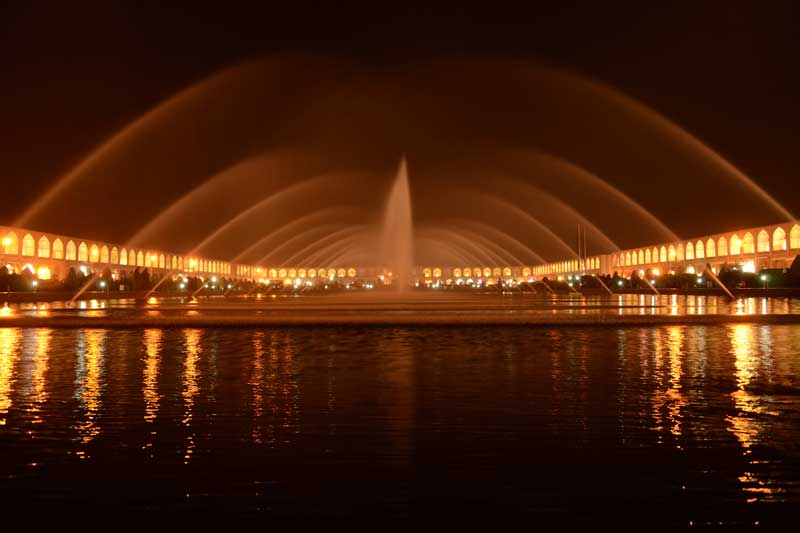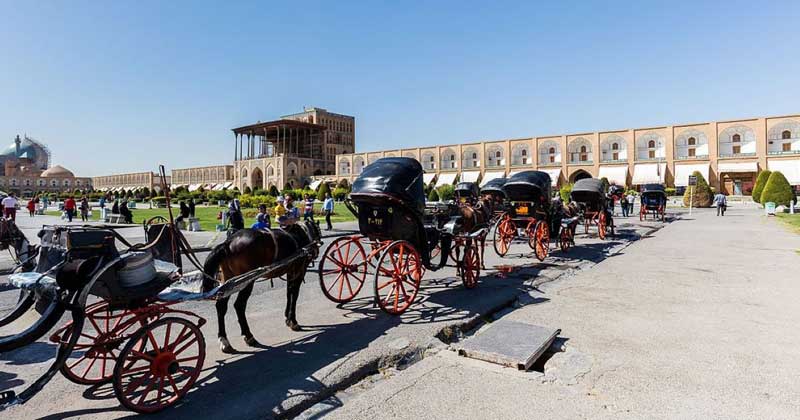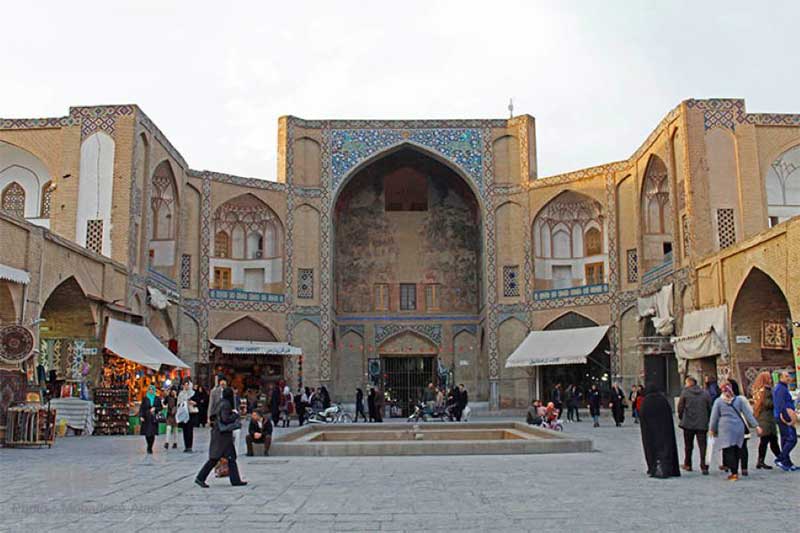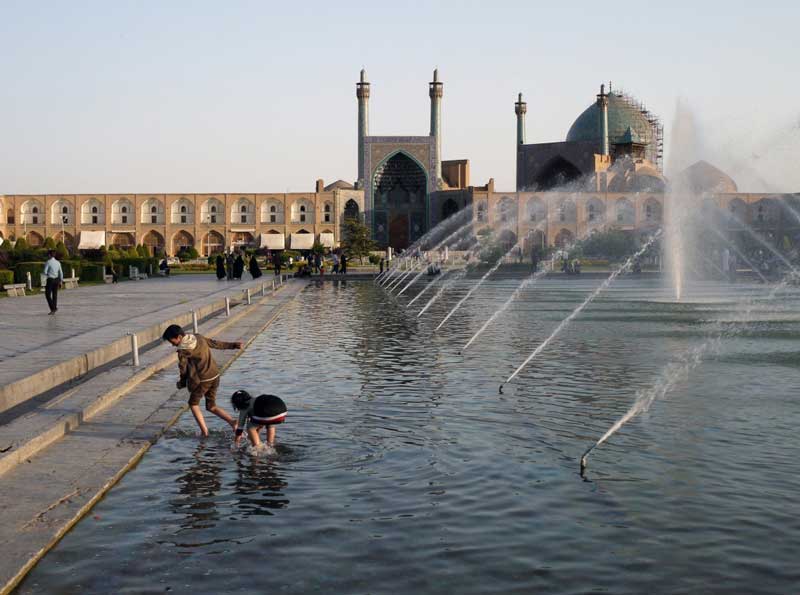
Constructed between 1598 and 1629 and located at the centre of Isfahan in Iran, Naghsh-e Jahan Square is one of the largest city squares in the world, surrounded by buildings from the Safavid era, reflecting outstanding examples of Iranian and Islamic architecture. While Naghsh-e Jahan stands for image of the world, the 560 feet (160 m) wide and 1840 feet (560 m) long square, covering a vast area of 964,000 sq feet (89,600 m), is also referred to as Shah Square or Imam Square and is one of UNCESCO World Heritage Sites in Iran. While the magnificent Shah Mosque is located on the south border of the huge square, Sheikh Lotfollah Mosque, one of the masterpieces of Iranian architecture, is situated on its eastern side.
The Ali Qapu Palace, which served as the official residence of Persian Emperors of the Safavid dynasty, stands on the western side of the square and on its northern side the historical Qeysarie Gate opens into the Isfahan Grand Bazaar. Bordered by rows of two-storey arcades and anchored on each side by four magnificent heritage buildings, the square complex looks like a place for trade, full of sellers’ tents, during the day, while during the evenings, it turns into an interesting entertainment site with jugglers, acrobats, dervishes and curious citizens. However, despite everything, the open green space in the centre of the square is just the one feature that makes Naghsh-e Jahan very special.

It all started in 1598, when Shah Abbas, the fifth Shah of Safavid dynasty decided to move the capital of the Persian Empire from the northwestern city of Qazvin to the central city of Isfahan as a more secure and convenient place against any possible future assaults by the Ottomans, the arch rival of the Safavids and also the Uzbeks.
At the same time, he also wanted to recreate the power structure of the country, which prior to the Shah's ascent to power, had a decentralised power-structure in which different institutions battled for power, Accordingly, the square became surrounded by several important buildings, among which the Shah Mosque and the Sheikh Lotfollah represent the power of the clergy, the Imperial Bazaar, represents the power of the merchants, while the Ali Qapu Palace, glorifies the power of the Shah.


Shah Mosque, also known as Masjid-i Imam , is the most prominent building, perhaps the Crown Jewel in the Naghsh-e Jahan Square and is considered as an excellent example of the masterpieces of Persian architecture in the Islamic era. Commissioned by Shah Abbas the Great, its splendour is mainly due to the beauty of its seven-colour mosaic tiles and calligraphic inscriptions.
The semicircular gateway to the mosque, measuring around 89 feet (27 m) and resembling a recessed half-moon, is flanked by two 138 feet (42 m) tall minarets, topped by aesthetically carved, wooden balconies. Along with Naghsh-e Jahan Square, the beautiful mosque is registered as a UNESCO World Heritage Site.


Of the four monuments that dominate the perimeter of the Naghsh-e Jahan Square, the first to be built was the Sheikh Lotfollah Mosque that stands on the eastern side of the square. Unlike the Shah Mosque, it was not meant for public and was built to be private to the royal court. Although breathtakingly beautiful, it is much smaller in size, less glorious than the Shah Mosque and does not have any minaret. However, the interior of the mosque is no less magnificent than the Shah Mosque and the most amazing decorative part in the interior is the design of a peacock, located at the centre of the dome, whose tail is the sunrays coming in from the hole in the ceiling, The walls, even the entrances of the mosque, are decorated with exquisite tile work with the so-called seven-colour tiles, complete with calligraphy, inscriptions of some chapters from the Quran.

Covering an area of around 16,145 sq feet (1,500 sq m), the 157 feet (48 m) tall Ali Qapu Palace is located on the western side of the Naghsh-e Jahan Square. The term Ali Qapu consists of the Arabic word Ali meaning high and the Turkish word Qapu, which stands for portal. Initially, it was a one-story building from the Timurid period and eventually it became the centre of Shah Abbas’s government in Isfahan, where the king and the courtiers held their meetings with the foreign ambassadors. The sixth floor of the Qapu Palace, popularly called the music room, contains the largest rooms of the building, where the royal reception and banquets were held. From the upper galleries, the Safavid ruler watched Polo games and horse-racing below in the Naghsh-e Jahan square.

The majestic Qeysarriyeh Gate that stands at the northern side of the Naghsh-e Jahan Square serves as the entrance to the Imperial Bazaar, a historical market and one of the oldest and largest roofed markets of the Middle East. The 2 km long vaulted market connects the old Atigh Square to the new Naghsh-e-Jahan Square and famous for carpets and rugs. However, it is also an interesting place to shop for souvenirs in the pleasant traditional atmosphere.

Apart from the four amazing structures around it, the square, decorated with fountains and green lawns, souvenir shops and ice-cream parlours, is an attractive for both the locals and the visitors. One can enjoy a walk along the square in sunset light or can take a horse drawn carriage around the square or make a wish into the centre fountain. Just before sunset, the area becomes calm, the atmosphere becomes cool and the lush grass becomes the perfect place to unwind.